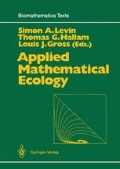Abstract
Despite advances in biology and medical science that have controlled many severe infectious diseases, influenza remains a recurrent problem, initiating new global pandemics because of its ability to change its form. In 1918–1919, an influenza pandemic (Spanish flu) killed about 20 million people and infected perhaps 2 billion. The special feature of this pandemic was a tendency towards bronchopneumonic complications fatal to previously healthy young adults. In Philadelphia, people were dying so quickly that bodies were stacked by the hundreds in temporary morgues, awaiting burial. Such horrible mortality caused tremendous social and economic disruption, and stimulated intensive research into the cause of the disease (Beveridge, 1977).
Access this chapter
Tax calculation will be finalised at checkout
Purchases are for personal use only
Preview
Unable to display preview. Download preview PDF.
References
Ackerman, E., Elveback, L.R., Fox, J.P. (1984) Simulation of Infectious Disease Epidemics. Thomas, Springfield, 111.
Anderson, R.M., May, R.M. (1986) The invasion, persistence and spread of infectious diseases within animal and plant communities. Phil. Trans. Roy. Soc. Lond. B314, 533–570
Bailey, N.T.J. (1975) The Mathematical Theory of Infectious Diseases and Its Applications, 2nd edn. Griffin, London
Baroyan, O.V., Rvachev, L.A., Basilevsky, U.V., Ermakov, V.V., Frank, K.D., Rvachev, M.A. and Shashkov, V.A. (1971) Computer modelling of influenza epidemics for the whole country (USSR). Adv. Appl. Prob. 3, 224–226
Baroyan, O.V., Rvachev, L.A. (1977) Mathematics and epidemiology. Moscow: Znanie (in Russian)
Beveridge, W.I.B. (1977) Influenza: the last great plague. Heinemann, London
Castillo-Chavez, C., Hethcote, H.W., Andreasen, V., Levin, S.A., Liu W. (1988a) Cross immunity in the dynamics of homogeneous and heterogeneous populations. Proceedings of the second autumn course on mathematical ecology
Castillo-Chavez, C., Hethcote, H.W., Andreasen, V., Levin, S.A., Liu W. (1988b) Epidemiological models with age structure and proportionate mixing
Choi, K., Thacker, S.B. (1981 a) An evaluation of influenza mortality surveillance, 1962–1979 (I) Time series forecasts of expected pneumonia and influenza deaths. Amer. J. Epid. 113, 215–226
Choi, K., Thacker, S.B. (1981 b) An evaluation of influenza mortality surveillance, 1962–1979(11) Percentage of pneumonia and influenza deaths as an indicator of influenza activity. Amer. J. Epid. 113, 227–235
Couch, R.B., Kasel, J.A. (1983) Immunity to influenza in man. Ann. Rev. Microbiol. 37, 529–49
Dietz, K. (1979) Epidemiologic interference of virus populations. J. Math. Biol. 8, 291–300
Dobson, A.P., May, R.M. (1986) Patterns of invasions by pathogens and parasites. In: Mooney, H.A., Drake, J.A. (ed.) Ecology of biological invasions of North America and Hawaii. Springer, Berlin Heidelberg New York
Elveback, L.R., Fox, J.P., Varma, A. (1964) An extension of the Reed-Frost epidemic model for the study of competition between viral agents in the presence of interference. Amer. J. Epid. 80, 356–364
Elveback, L.R., Fox, J.P., Ackerman, E., Langworthy, A., Boyd, M., Gatewood, L. (1976) An influenza simulation model for immunization studies. Amer. J. Epid. 103, 152–165
Fine, P. (1982) Background paper: applications of mathematical models to the epidemiology of influenza: a critique. In: P. Selby (ed.) Influenza models: prospects for development and use. Sandoz Institute for Health and Socio-economic Studies, pp. 15–85
Friedman, R.M. (1981) Interferon: a primer. Academic Press, New York London Toronto Sydney San Franscisco
Garnick, E. (1986) A theoretical consideration of resource specialism vs. generalism in parasites and some related questions. Ph.D. Thesis, Cornell University
Hale, J.K. (1969) Ordinary differential equations. Wiley Interscience, New York
Hethcote, W.H. (1978) An immunization model for a heterogeneous population. Theor. Pop. Biol. 14, 338–349
Holt, R.D., Pickering, J. (1986) Infectious disease and species coexistence: a model of Lotka Volterra form. Amer. Nat.
Kermack, W.O., McKendrick, A.G. (1927) Contributions to the mathematical theory of epidemics, pt. I. Proc. Roy. Soc. All5, 700–721
Kilbourne, E.D., (ed.) (1975) The influenza viruses and influenza. Academic Press, New York London Toronto Sydney San Franscisco
Liu, W. (1987) Dynamics of epidemiological models-recurrent outbreaks in autonomous systems. Ph.D. Thesis, Cornell University
London, W.E., Yorke, J.A. (1973) Recurrent outbreaks of measles, chicken pox and mumps, I. Seasonal variation in contact rates. Amer. J. Epid. 98, 453–468
Longini, I.M., Fine, P.E.M., Thacker, S.B. (1983) Predicting the global spread of new infectious agents. Amer. J. Epid. 123, 383–391
Palese, P., Young, J.F. (1982) Variation of influenza A, B, and C viruses. Science 215, 1468–1474
Rvachev, L.A., Longini, I.M., Jr. (1985) A mathematical model for the global spread of influenza. Math. Biosci. 75, 3–22
Selby, P. (ed.) (1982) Influenza models: prospects for development and use. Sandoz Institute for Health and Socio-economic Studies
Serfling, R.E. (1963) Methods for current statistical analysis of excess pneumonia-influenza deaths. Publ. Hlth. Rep. 78, 494–506
Shope, R.E. (1936) The incidence of neutralizing antibodies for swine influenza virus in the sera of human beings of different ages. J. Exp. Med. 63, 669–684
Spicer, C.C. (1979) The mathematical modelling of influenza epidemics. Brit. Med. Bull. 35, 23–28
Stuart-Harris, C.H. Schild, G.C. (1976) Influenza, the viruses and the disease. Publishing Sciences Group, Littleton, Mass.
Thacker, S.B. (1986) The persistence of influenza A in human population. Epid. Rev. 8, 129–142.
Webster, R.G., Laver, W.G., Air, G.M., Schild, G.C. (1982) Molecular mechanisms of variation in influenza viruses. Nature 296, 115–121
Editor information
Editors and Affiliations
Rights and permissions
Copyright information
© 1989 Springer-verlag Berlin Heidelberg
About this chapter
Cite this chapter
Liu, Wm., Levin, S.A. (1989). Influenza and Some Related Mathematical Models. In: Levin, S.A., Hallam, T.G., Gross, L.J. (eds) Applied Mathematical Ecology. Biomathematics, vol 18. Springer, Berlin, Heidelberg. https://doi.org/10.1007/978-3-642-61317-3_10
Download citation
DOI: https://doi.org/10.1007/978-3-642-61317-3_10
Publisher Name: Springer, Berlin, Heidelberg
Print ISBN: 978-3-642-64789-5
Online ISBN: 978-3-642-61317-3
eBook Packages: Springer Book Archive

